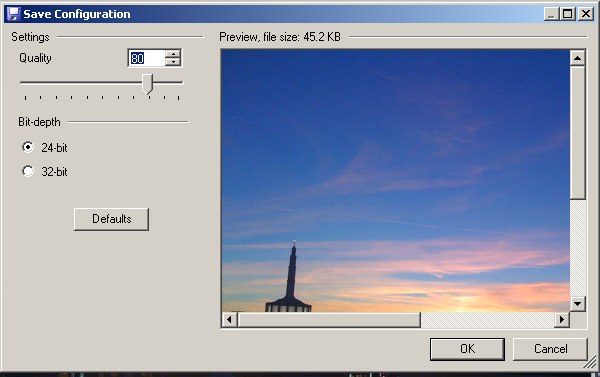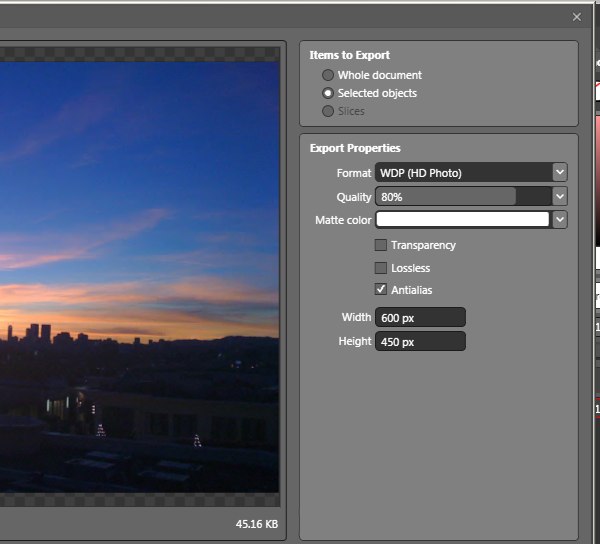One of the new features in IE9 is the support for the JPEG-XR format, which reportedly has a better compression. Is it something we should dive into ASAP?
JPEG-XR
The wikipedia article is here. This format is developed and patented (red flag!) by Microsoft (yellow flag! 🙂 ), it replaces the suggested JPEG-2000 format and is an official standard as of mid '09. It's formerly known as "HD photo" and "Microsoft something something" and is heavily used in Vista and Windows 7 - two OSes I'm yet to experience. Anyway.
The wikipedia article says that the format has a better compression, so I had to take a look at it!
Software support
That's where the problems start. The list of software that supports the format is not too long and most of the software just reads it, like IE9. IE9 doesn't run on XP, so I couldn't actually test it.
What I managed to try was:
- a plugin for Paint.NET that read/writes JPEG-XR
- a 60-day trial version of MS' Expression Design 3 that reads/writes - this required an upgrade of my .Net platform, so the whole process took forever on the poor XP VMWare (but hey, I have a book to finish, so no distraction is too long!)
- a plugin for IrfanView that reads the format
Nothing for Mac though.
There's rumors all over the place that MS have a beta version of a Photoshop plugin that works on the Mac, but even the MS' press release linked to a 404. (which redirected to a bing search - here's the secret to gaining search market share!)
Actually before I digged into these programs, my first instinct was to check if ImageMagick supports this format. Turns out no. IMagick used libjpeg like pretty much all image programs out there and curiously enough here's what libjpeg's README has to say:
FILE FORMAT WARS ================ The ISO JPEG standards committee actually promotes different formats like JPEG-2000 or JPEG-XR which are incompatible with original DCT-based JPEG and which are based on faulty technologies. IJG therefore does not and will not support such momentary mistakes (see REFERENCES). We have little or no sympathy for the promotion of these formats. Indeed, one of the original reasons for developing this free software was to help force convergence on common, interoperable format standards for JPEG files. Don't use an incompatible file format! (In any case, our decoder will remain capable of reading existing JPEG image files indefinitely.)
Sounds like another red flag to me. IDG (Independent JPEG Group) are the creators of libjpeg. If libjpeg doesn't sounds like it will support it JPEG-XR, that means adoption can be really slow if not feasible at all. But even if IE is the only browser under the sun that supports the format and the format is so much better, then there might be cases where it could be beneficial to browser-sniff and send different image versions, as far-fetched as that may sound.
Test in Paint.NET
I started with Paint.NET because it was the easiest. I took a photo I've taken with the iPhone, keeping the use case real, and resized to a 600x450px which sounds like a normal thing to do in a blog post for example. I used IrfanView and PNG, so that the original is lossless (click the thumb for the actual source image).
I converted the photo with Paint.NET to JPEG and to JPEG-XR (also called WDP/HD Photo). In both cases I used quality of 80%. There was also an option for WDP which was 32bit image by default, which I changed to 24 bits because the image was smaller filesize.

The results were - 45K for XR/WDP and 24K for JPEG. So the good old JPEG was smaller - the exact opposite of what should've happened. Additionally JPEGTran shaved off another 1.3K from the file. Seemed like JPEG-XR is not that good after all. But as I said I had a book to write so I kept going with the distractions, determined to avoid writing for as long as I can.
Test with Expression Design
Expression Design produced the exact same WDP/HD Photo/JPEG-XR file - 45K. And this is not surprising actually, since there is an image framework from MS, called WIC, part of .Net, which is probably what Paint.NET and Expression Design both use. But surprisingly enough the JPEG outcome from Expression Design was significantly bigger - 57K. What?!
Then I looked at the visual quality and the number of colors and it turned out the JPEGs were pretty different, although they were converted from the same PNG and using 80% in both programs.
| Software/Format | JPEG | JPEG-XR aka WDP aka HD Photo |
|---|---|---|
| Paint.NET | 24K (50 000+ colors) | 45K (104 000+ colors) |
| Expression Design | 57K (54 000+ colors) |
Visually the JPEG from Paint.NET is clearly lower quality than the one from Expression Design and from the WDP format. Interestingly, IrfanView produced an pretty much identical file when converting the PNG to JPEG with quality 80. So Expression Design seems to be doing something differently.
Using IrfanView I increased the quality of the JPEG until the file size reaches the file size of the WDP. (After all, all I want to know is which format has the smaller filesize). The quality of 93 resulted in a JPEG that was about the same file size as quality 80 JPEG-XR. Then I tried so look at the visual quality and although I'm not a designer, it seemed to me that the two images are pretty identical and XR is maybe just a little better. But that's a little subjective.
Here's the two files for comparison. Let me know which one you think is better. In this case they are both losslessly converted to PNG, so all browsers can see the WDP.
Here's also an image diff (from ImageMagick's compare) - it shows that technically the two images are very different (the white dots are pixels with the exact same color values)
One other thing about Expression Design - when exporting WDR, it has a "transparency" checkbox ON. This results is bigger images, so make sure you turn it off when using, it makes no sense for photos.

Batch conversion?
My motivation in this experiment was to see if there's a way (and a reason) to do a batch conversion of all JPEG imagery to JPEG-XR. This would be my favorite performance optimization - you run one script and wake up to a 5-10% less image bandwidth.
Looks like JPEG-XR could probably look better for the same filesize, meaning maybe a smaller filesize for the same quality. But it's not easy to decide when it comes to quality and certainly even harder for a machine (a simple batch conversion script) to tell. I was hoping that there's a way to losslessly convert to JPEG-XR. From what I can see, there isn't. JPEG-XR does have a lossless option but it creates huge files (like 250K instead of 45), so the lossless versions are not meant to be on the web. BTW, the lossless option is the same as 100 quality (which is not the same in normal JPEG, where even 100% is lossy).
So, in conclusion - JPEG-XR may look promising but is currently unusable for practical purposes, because of
- the extremely limited support in browsers (browser, actually),
- very limited choices of creation software
- the benefits are hard to distinguish
- not possible to batch-and-forget process all old JPEGs
And there's the other turn off - patents. Although Microsoft has promised to promise not to sue people around for implementing JPEG-XR, a patent is a patent and all software patents must die on general principle 🙂





